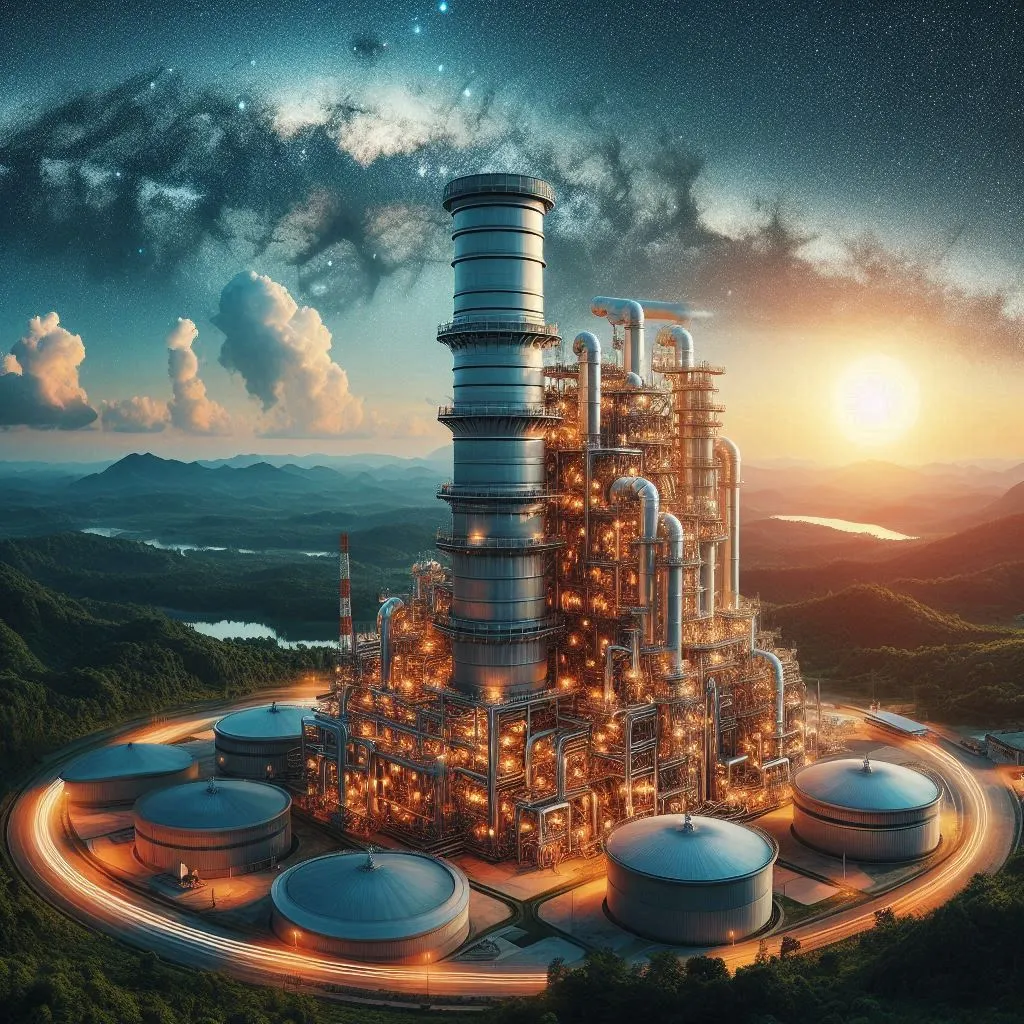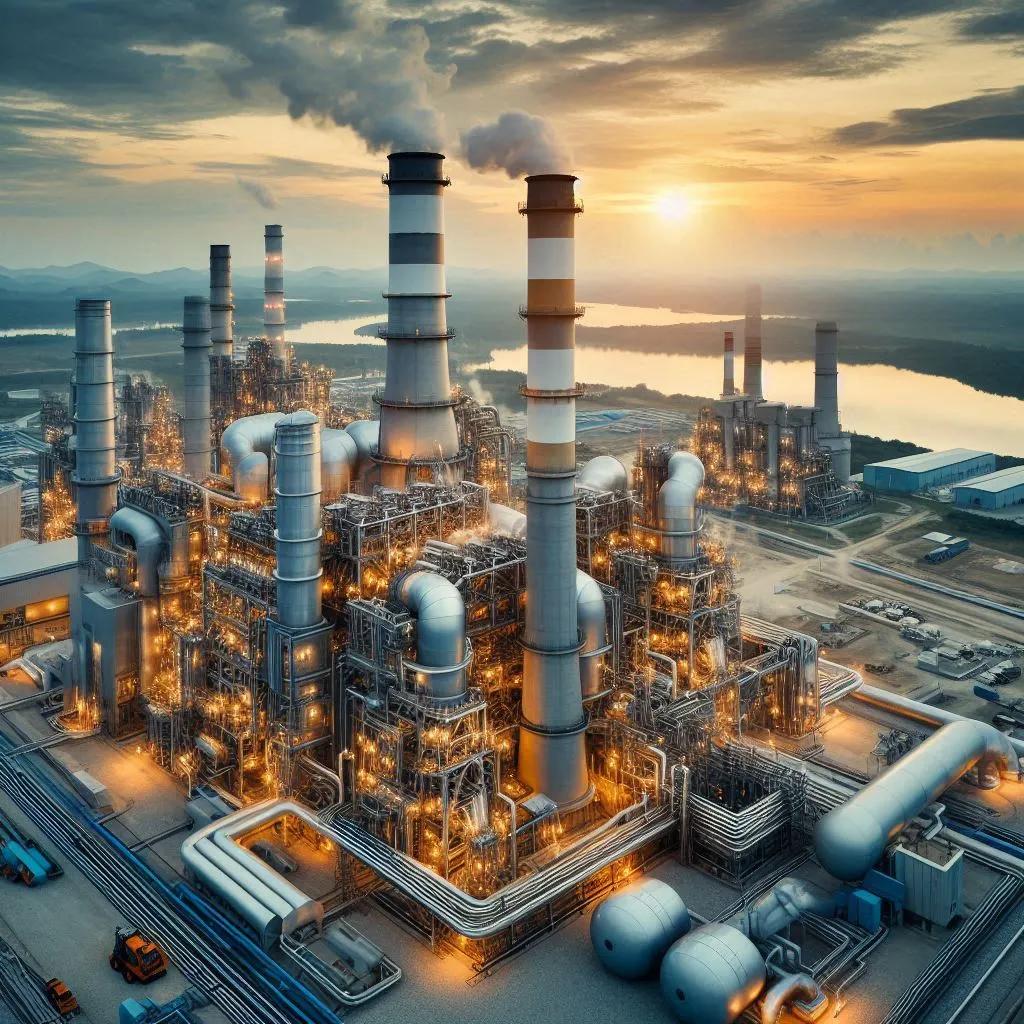Table of Contents
A combined cycle gas power plant (CCGPP) combines gas and steam turbines to produce electricity. The waste heat from the gas turbines is reused to generate additional electricity, passing it through the steam turbine generator. This process is highly efficient and produces lower carbon emissions than traditional power plants.
These combined-cycle gas turbine (CCGT) plants are commonly used in urban areas to supply electricity. Similarly, the CCGT power plant is also used in the industrial sector to power manufacturing plants, refineries, and other large-scale industrial operations.
Additionally, combined cycle power plants (CCPP) are increasingly being utilized in countries like the United States, Europe, and Japan, where the focus is to bridge the gap between traditional fossil fuel-based power output and renewable energy sources, thus reducing carbon footprints. By providing a more efficient and cleaner alternative to coal-fired power plants, the CCGT power plant helps reduce greenhouse gas emissions by using renewables like wind and solar power into the grid. This versatility and adaptability make combined cycle gas power plants a key component in the global shift towards more sustainable energy systems.
What is the Combined Cycle of a gas power plant?
A dual-turbine setup in which natural gas is combusted in a combustion chamber, producing electricity and hot exhaust gases. This high-temperature exhaust is captured and used to generate steam in a heat recovery steam generator (HRSG). This steam is passed through a steam turbine that will produce more electricity.

This combined cycle maximizes fuel energy utilization, significantly increasing the plant's energy efficiency. As a result, combined-cycle gas power plants can achieve efficiencies of over 60%, compared to around 35% for traditional single-cycle plants, while reducing carbon emissions.
How does a CCGT power plant work?
In the first stage, natural gas is burned in a combustion turbine (gas turbine). Due to the high temperatures, the natural gas produces heat, leading to electricity generation. In the second stage, the exhaust gas or waste heat produced is directed to a heat recovery steam generator (HRSG). Here, the hot exhaust gas produces steam. This steam is then passed into a steam turbine, which not only generates additional electricity but also plays a crucial role in maximizing the efficiency of the overall process.
By efficiently harnessing the waste heat from the gas turbine generator to power the steam turbine, a CCGT power plant achieves significantly higher overall efficiency levels than a traditional simple cycle plant.
What are the types of combined cycle plants?
The Brayton cycle converts natural gas to mechanical energy, while the Rankine cycle uses waste heat to generate additional power through steam production and expansion. Let us understand them in detail:
Brayton Cycle (Gas Turbine Cycle): In this process, the natural gas is converted into mechanical energy. It involves compressing and mixing the natural air with fuel to create combustion. In this combustion turbine, under high pressure and temperature, gas is passed through turbine blades to produce mechanical work. It is one of the primary cycles used in gas power plants.
Rankine Cycle (Steam Turbine Cycle): In this cycle, additional power is generated using waste heat from the gas turbine cycle. The HRSG captures the exhaust heat from the gas turbine and uses it to produce steam.
What is the efficiency of CCGT?
The efficiency of combined cycle gas turbines (CCGT) typically ranges from 28% to 33% for the gas turbine alone. This efficiency can be further improved to around 60% by recovering low-grade thermal energy from the exhaust gas for the steam turbine process, making it a highly efficient thermal power plant.

The utilization rate of CCGT power plants in the U.S. has significantly increased, from 40% in 2008 to 57% in 2022. The introduction of more advanced turbine technology since the mid-2010s has contributed to this efficiency boost.
What are the benefits of CCGT?
A combined cycle plant has several benefits, such as reduced carbon emissions, improved cost-effectiveness, and enhanced efficiency. The benefits of CCGT are listed below:
- High Efficiency: A natural gas power plant achieves higher thermal efficiency than traditional single-cycle power plants. Utilizing the Brayton (gas turbine) and Rankine (steam turbine) cycles, they can convert more fuel energy into electricity, often reaching efficiencies of around 60%.
- Lower Emissions: Due to their higher efficiency, CCGT plants produce less carbon dioxide (CO2) and other pollutants per unit of electricity generated than conventional coal or oil-fired power plants. This makes them a cleaner option for power generation.
- Cost-Effectiveness: The higher efficiency and lower fuel consumption of CCGT plants reduce operating costs. Natural gas is often cheaper and cleaner than other fossil fuels, enhancing cost-effectiveness.
- Versatility in Fuel Use: While natural gas is the primary fuel, CCGT plants can be adapted to use other fuels, including biogas and syngas from coal or biomass gasification, providing versatility in fuel sources.
Find Gas Power Projects and Tenders GloballyClaim Free Leads!
Current and Future of CCGT
The use of a combined cycle system grew immensely over the years. The US gas consumption rose by 5% due to increased use in power generation amidst coal supply constraints and rising coal prices. Forecasts for 2023 predict a 1% increase in global gas consumption, driven by demand from the US, China, and emerging Asia Pacific countries. Gas power generation is one of the largest reliable sources, accounting for 44% of global consumption in 2022, despite a slight 0.2% decrease due to gas-to-coal switching. The combined cycle power sector will continue driving global gas consumption as countries move away from coal-fired plants. However, in 2022, global gas consumption declined by 0.4% year-on-year to 4.03 trillion cubic meters (TCM), influenced by mild winter weather in the Northern Hemisphere and high gas prices impacting industrial use in Asia Pacific and Europe.

List of CCGT power plant Companies in the World
- Kawasaki Heavy Industries
- Siemens Energy AG
- EDF
- ENGIE
- Bharat Heavy Electricals Limited
- Duke Energy
- Enel
- GE gas power
- General Electric
- Iberdrola
- Mitsubishi Power, Ltd.
- Solar Turbines
- Ansaldo Energia
- China Huaneng Group
Conclusion
Combined Cycle Gas Turbine (CCGT) power plants represent a significant advancement in power generation technology, combining gas and steam turbines to achieve high efficiency and lower carbon emissions. This efficiency, combined with reducing carbon emissions and adapting to various fuel sources, makes Combined cycle gas turbine plants a cleaner and more cost-effective option for power generation in urban and industrial settings. The U.S. and other nations are likely to continue expanding their use of CCGT technology, driven by advancements in turbine efficiency and focus on reducing greenhouse gas emissions. As a result, CCGT power plants will remain a key component in the global shift towards more sustainable and reliable energy systems.
Find Gas Power
Projects and Tenders Globally Claim Free Leads!
FAQ’s
Does CCGT use coal?
Combined cycle gas turbines use natural gas as a fuel. However, coal can be used as an alternative fuel source.
What is the technical life of a CCGT plant?
The technical life of CCGT can be 25-30 years. However, proper maintenance and regular checkups can extend the lifespan to 45-50 years.
Which gas is used in a gas power plant?
Natural gas is used in a gas power plant as a fuel. It can be processed through an open or combined cycle power plant.
Collaborate with decision-makers of Gas Power Plants across the globe for business opportunities.
Subscribe to our Global Gas Power Plants Projects database and receive exclusive benefits like
- Regular updates on Gas Power plant projects and tenders
- Exclusive Access to our Gas Power plant projects global Database
- In-progress and Completed Gas power plant projects
- Essential details, Timely Updates, Key Stakeholder Contact Information
- Industry Trends and insights by experts
Start a free demo to take your business to the next level!

Leave a Comment
We love hearing from our readers and value your feedback. If you have any questions or comments about our content, feel free to leave a comment below.
We read every comment and do our best to respond to them all.